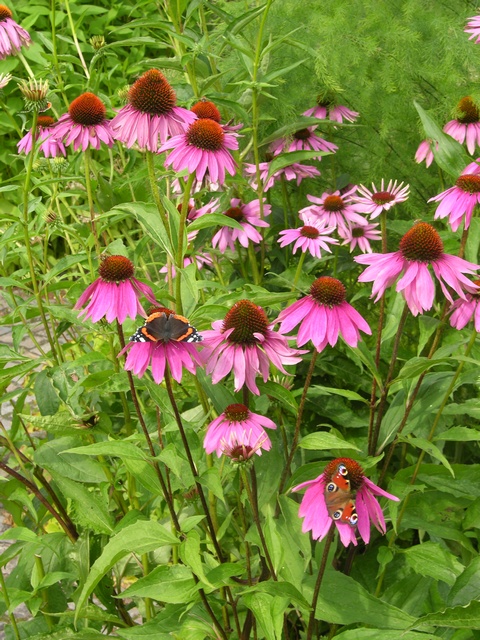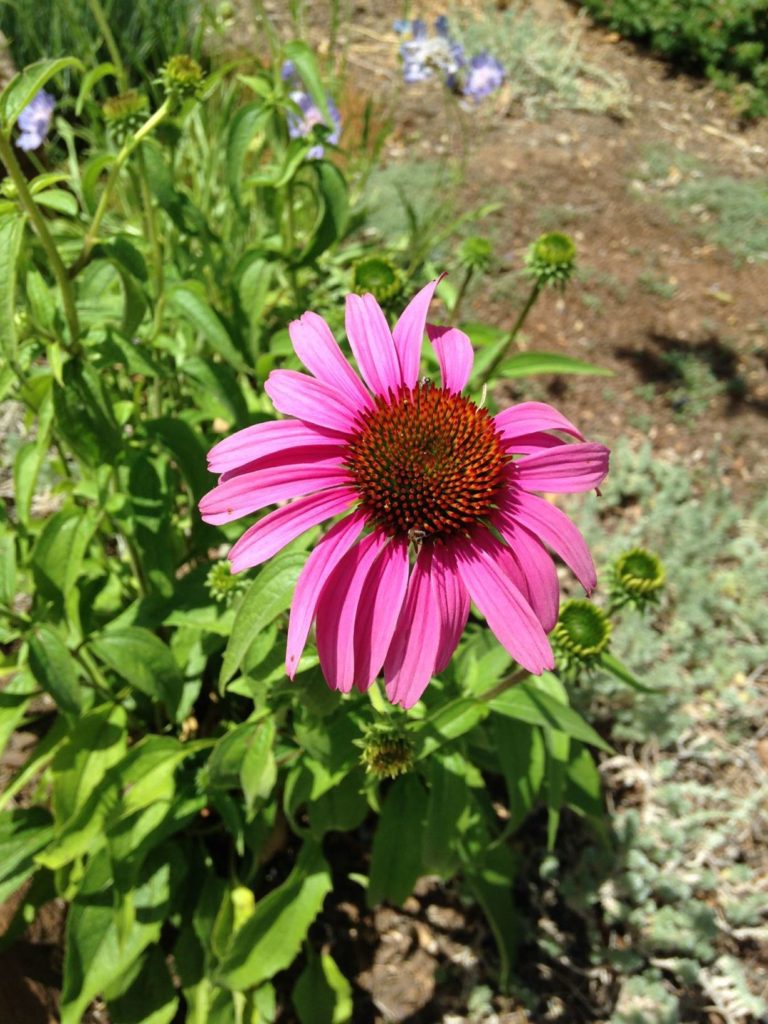Scientific name: Echinacea purpurea
Common name: purple coneflower
Family: Asteraceae
Article by Susan Bruneni
The purple coneflower is a true native North American plant, growing primarily east of the Rocky Mountains. Other plants discovered in the New World such as tomatoes, squash, potatoes and tobacco were introduced to the Old World quickly, but the purple coneflower, or Echinacea, took its time. It was used widely by Native Americans for centuries before colonization. Concoctions were made from all parts of the plant to treat a vast array of conditions. When settlers arrived they learned from Native Americans how to treat numerous conditions with native plants.

Echinacea purpurea Photo © Biopix: JC Schou
Purple coneflower is widely found on American prairie land not native to New Mexico. Seed and plants are readily available through local nurseries and will grow well in Santa Fe gardens if natural growing conditions are duplicated. Two thriving cultivar examples are planted at SFBG’s Museum Hill site: ‘Magnus Superior’ coneflower and POWWOW WILD BERRY purple coneflower.

Echinacea purpurea ‘Magnus Superior’
“Purple coneflowers do not grow wild in northern New Mexico” says local herbalist Seraphina Tisch who specializes in native plants. Natural conditions for seed germination are not favorable (follow instructions on seed packet). “But purple coneflowers are readily available at local nurseries and make a striking addition to gardens. There are also herb farmers who produce and harvest plants for sale,” she added.
It is easily grown in average, dry-to-medium, well-drained soil in full sun to part shade. It is an adaptable plant tolerant of drought, heat, humidity and poor soil. Plants usually re-bloom without deadheading. It freely self-seeds if at least some of the seed heads are left in place.
Excellent, long-blooming flowers are perfect for massing as a border, meadow, native plant garden, naturalized area, wildflower garden or part-shade area of a woodland garden. The genus name of Echinacea comes from the Greek word echinos meaning hedgehog or sea-urchin in reference to the spiny center cone found on most flowers in the genus. It attracts birds, butterflies, bees. Native lore refers to herds of elk seeking out purple coneflower to feed upon.
Purple coneflower typically grows to 2-4-feet tall. Showy daisy-like purple coneflowers (to 5-inches diameter) bloom throughout summer atop stiff stems with coarse, ovate to broad-lanceolate, dark green leaves. Flowers are suitable for fresh or dried arrangements. The dead flower stems will remain erect well into the winter, and if flower heads are not removed, the blackened cones supply seeds for hungry birds.
There are nine species of Echinacea but the most common is Echinacea purpurea. It has a fibrous root. All other Echinacea have tap roots. Echinacea angustifolia is also used for herbal preparations.
Popularity of Echinacea grew for medicinal use tremendously between 1830 to 1930, primarily due to the influence of “The Eclectics”, a significant group of doctors who depended heavily on botanical medicine. Several larger works on materia medica and therapeutics have been reprinted and are available today. During that period purple coneflower was primarily used for immune system support and upper respiratory issues.
In 1870, H.F.C. Meyer introduced “Meyer’s Blood Purifier” an Echinacea extract. Eager to make money, he made wild claims for his “cure-all” and even proposed submitting himself to a rattlesnake bite and then using his tonic to heal himself. Doctors scoffed and refused the offer, and branded Meyer a fraud. Hence, the terms snake oil and snake oil salesman were applied to Meyer and popularity of his blood purifier declined. It remained on the market, largely due to a 75-percent alcohol content.
By 1912 however, Echinacea recovered from it snake-oil reputation. A survey of medical use of 200 herbal medicines showed it to be in the top ten, or even number one. One of the doctors who scoffed at Meyer realized his mistake and began serious research. When American interest waned, German researchers took over and continued in Europe.
Echinacea purpurea is now widely used North America, and Europe (especially Germany). Since then, this preparation has undergone numerous clinical trials, which has supported its traditional use by Native American people as a sovereign remedy for colds, flu, bronchitis, toothache, infections—and snake bites.
Resources
Ladybird Johnson Wildflower Center
Missouri Botanical Garden
USDA
Wikipedia
iNaturalist (Plants of the Rio Grande Bosque)


